A central focus of the work of Kathie Shaw looks at our relationship to each other and our environment. Shaw’s paintings reside in a space between realism and abstraction, and are influenced by her relationship with Tibetan Buddhism, architectural studies, and ongoing photography investigations. The COMP Magazine recently visited Shaw’s Ravenswood studio that she shares with her husband, artist Corey Postiglione, to discuss her use of found imagery, how the painting process can be meditative, and her series of Post Apocalyptic Trash Paintings.
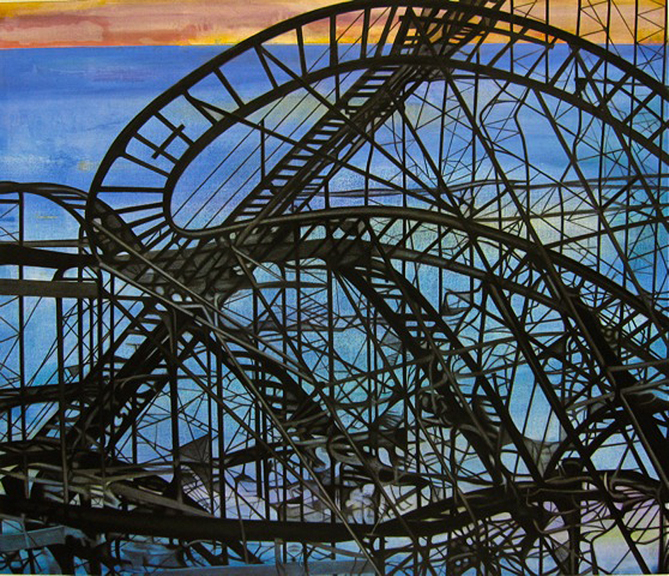
Kathie Shaw, Jet Star Hurricane Sandy, 2014, charcoal and acrylic on canvas, 48″ x 54″
Can we start with your affinity with painting? You have a rather interesting background. You’ve studied with some amazing artists (Ray Yoshida, Philip Hansen, and Michiko Itatani), practice as an architect, and hold a lasting influence with Tibetan Buddhism. So, where does painting rest in your approach to life and work?
Earlier in my life I always seemed to be in a position of having to support myself financially, which limited my time making art, more specifically painting. Fortunately, I have always been able to work around and with art, first at the Art Institute and secondly at Jan Cicero Gallery here in Chicago. I have also studied photography, so I have always been interested in picture taking, which can be (but is not necessarily) somewhat easier to pursue when one has limited time. Digital photography, especially, has helped open up a lot of space within that medium. Everyone is now a photographer.
Eventually, I decided to go back to school to study architecture, a subject I had also been interested in since childhood. Of course, architecture is also art. I guess you could say that my interest in Buddhism has helped me to view life itself as something that can be approached as an art form, too. Buddhism prepares the mind, and this can’t help but open up pathways having to do with creativity. I feel very fortunate to be able to pursue painting again after many years. The act of painting is a meditative process for me.
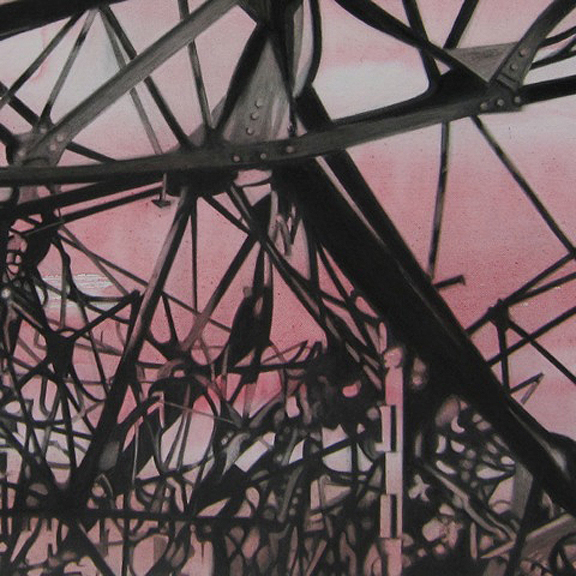
Kathie Shaw, Cherry Blossom Sky Hiroshima, 2012, charcoal & acrylic on canvas, 30″ x 30″
Can you discuss the content of your work, upon a surface reading, one might focus upon the formal elements and techniques. However, there is reference to environmental concerns and other factors due to the human imprint being made on our planet.
Here you are referring to my series entitled Post Apocalyptic Trash Paintings, i.e. art as trash blowing around an uninhabited planet. The title of the series is not a soft reference. It is a reference to the possibility of extinction, human extinction. We have reached the tipping point with climate change, and scientists are now saying we are facing extremely dire circumstances based on the rapidly melting polar ice caps. We are on the brink of changing life as we know it on the planet, and yet there is a contingent of people running the most powerful government on the planet that keeps claiming humans haven’t caused this, and there’s nothing we can do about it. Well, their self-fulfilling prophecy and the results of their stubborn inaction are now coming to fruition. We have no idea how the future is going to play out.
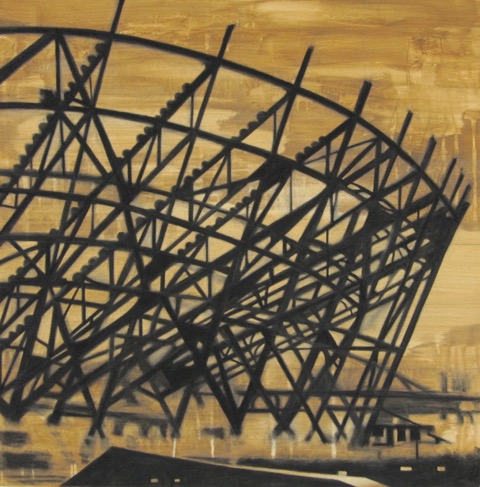
Kathie shaw, Olympic Stadium London, 2009, 30 x 30 inches, acrylic/charcoal on canvas
As I tend to work very intuitively, this series came to me while reading the New York Times. I saw a black and white reproduction of a photograph of the London Olympic Stadium under construction. In my view, all the spending that happens when the Olympics come to a city is extremely wasteful – especially spending on new stadiums – usually paid for with tax payer’s money. Chicago suffered with a very bad parking meter deal as part of former Mayor Daley’s attempt to raise money to bring the Olympics to Chicago. The money he made by selling our parking meters made it appear that we were better off than we actually are. In my view fortunately we still didn’t get the Olympics in Chicago, but we are still living with parking rates that are twice that of Evanston, for instance, even in our poorest neighborhoods.
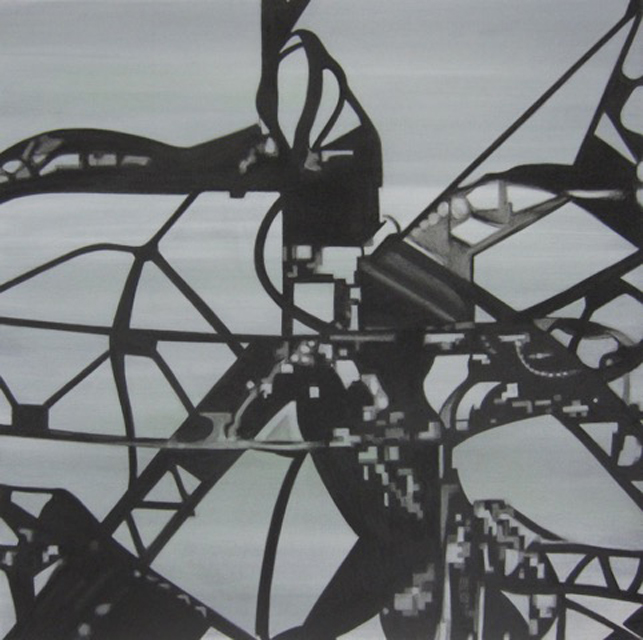
Kathie Shaw, Detritus: Hiroshima II, 2013, charcoal and acrylic on canvas, 18 x 18 inches
Often these stadiums are not used much after the Olympics have left town. I loved the photograph, as the black and white grainy reproduction made it look like a hulk or a ruin, and this linked up perfectly with my thoughts about spending on the Olympics. I decided to try to make a painting based on the photograph. In order to keep the rough quality of the image, I opted to use charcoal on canvas. So, this is how the series began. I have included images of war, specifically compositions from photos taken at Hiroshima after the bomb was dropped, an oil rig from the Gulf of Mexico started weeks before the Deep Water Horizon blew up, electric power grid structures, and most recently a larger painting of the Jet Star Roller Coaster that ended up in the Atlantic Ocean after Hurricane Sandy.
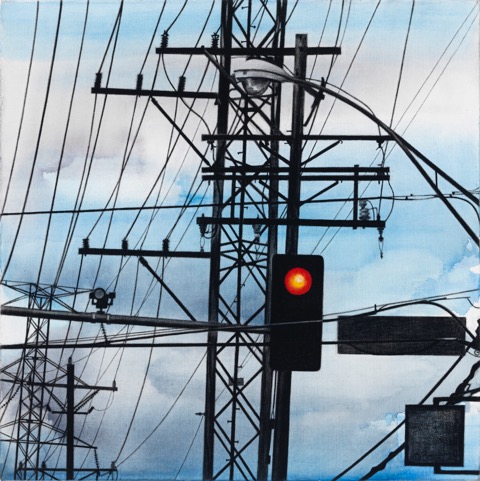
Kathie Shaw, Stop I See You, 2013, charcoal and acrylic on canvas, 18 x 18 inches
You often use source materials (photographs). Are these images appropriated or taken by yourself? Would you share your process for developing the final paintings?
I use both found photographs and photographs I take myself. I copy the photograph, sometimes enlarging it to suit my purpose. I then choose a composition within the picture using a mask that has been proportioned into a grid. I transfer the grid to the canvas and begin section by section to transpose the image to the canvas. I don’t use projection. I attempt to reproduce each square in the grid by eye on to the canvas. It is a rather laborious process, but that is where the meditation comes in. I layer the charcoal and then use erasers to finesse the line. It can take several hours to finish a very small area. It provides a lot of time to think, ponder, listen to music, or just concentrate on the action of drawing itself.
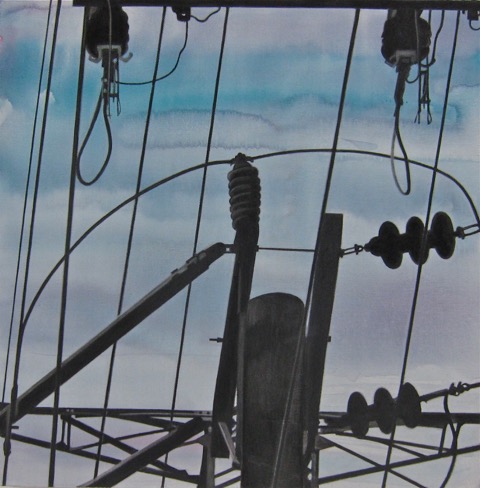
Kathie Shaw, Source of Light and Darkness I, 2012, charcoal and acrylic on canvas, 30 x 30 inches
For additional information on the work of Kathie Shaw, please visit:
Kathie Shaw: http://kathieshaw.com/home.html
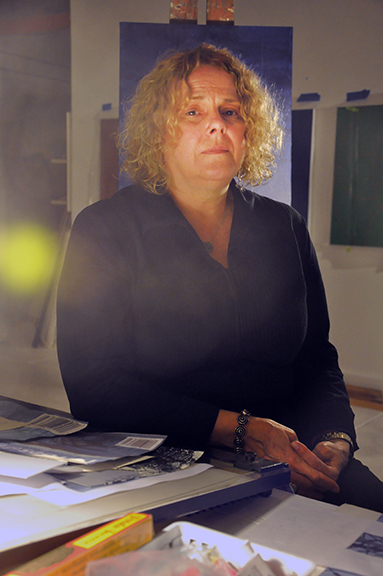
Kathie Shaw, painter, Chicago, 2014
Interviewed and portrait by Chester Alamo-Costello


